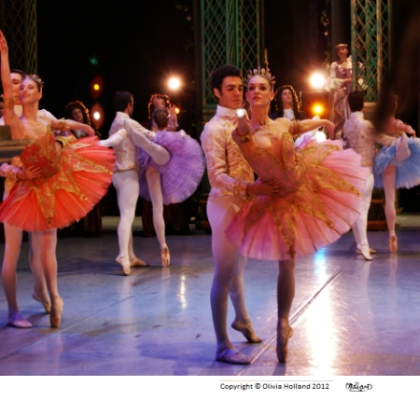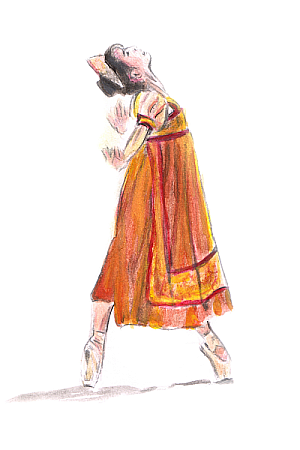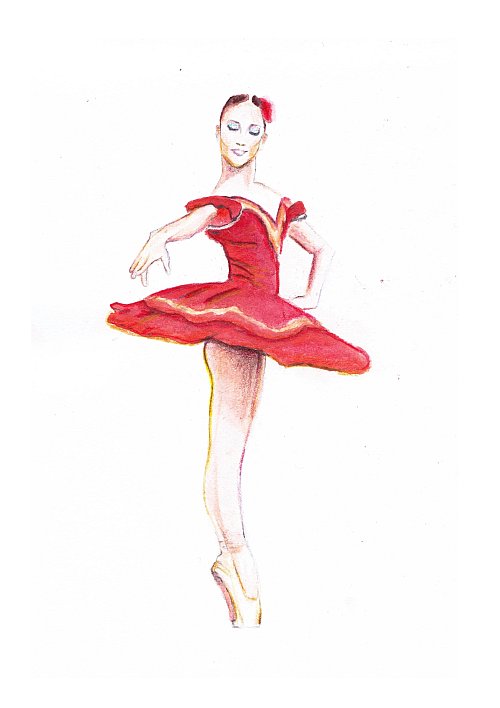Ballet Terms
Simple, Easy and Clear
Here is an A to Z glossary and the ultimate dance dictionary. If there is a certain word you need to find in ballet, then look below. It is all you will ever need to know!
Odette's dictionary is listed alphabetically on four different pages and you will find both the term and the definition.
Remember, the basic ballet steps are crucial in order to progress your dancing. You can begin by understanding the key terms and learning the basic steps to perfect.
If you haven't found the you were looking for, then do not worry. I designed a special visitor sections just for you to have your say at the bottom of this Ballet Terms Page.
Odette's Ballet Dictionary!
Listed alphabetically:

Since ballet terms can often be tricky to pronounce, I have included the word translations in brackets to help you say the terms.
A
Adage, Adagio (a-DAHZH) At ease or at leisure.
Adage is incorporated into ballet classes and most classical pas de deux combinations.
It is a series of slow, graceful exercises during the centre practice which is generally focused on line, balance and fluidity. It takes lots of practice to gain the stability and control whilst still having a sense of fluid movement.
En L'Air (ahn lehr) In the air.
This ballet term is generally associated with ballet movements that are in the air. For example, tour en l'air which is a high turning jump mainly for the male dancers.
It indicates that for ballet exercises like rond de jambe and adage the leg should be lifted off the floor, such as rond de jambe en l'air.
Allégro ([a-lay-GROH) Bright and brisk movements. This ballet term is associated to all jumps in ballet. So, whether it is petite allégro, or grand allégro a dancer will aim to show a sense of ballon and spring in the elevation.
Arabesque (a-ra-BESK) This is one of the basic poses in ballet. The position of an arabesque shows one leg as the supporting leg and the other extended behind you. The arms can be held in various positions to show a first, second, or third arabesque.
An arabesque is like a tendu derriere but lifted en l'air. The aim is to lift the leg without showing too much adjustment in the body, such as pitching forward. Also, the leg should be in a direct line behind the spine and the shoulders should remain square.
En Arrière (un na-RYEHR) Backwards. This is used to express a step travelling backwards. For example, glissade en arrière.
Assemblé (a-sahn-BLAY) Assembled or joined together.
This step is used in a combination of allegro and usually has a preparation of a glissade. It is taken from fifth position where the front, or back leg if in reverse, uses the floor pressure to push along the ground and join both legs together in the air.
The aim is to show a fifth position in the air, like a soubresaut, then land back again in a fifth position. It can be a small or high jump depending on the allegro exercise.
Attitude (a-tee-TEWD) The pose is similar to an arabesque, but the lifted leg is bent at a 90 degree angle. The lifted leg should be as turned out as possible, so the knee is not dropping and aimed to be higher than the foot.
En Avant(un na-VAHN) Forwards. If a step is travelling forward, it is explained by saying, 'En Avant', such as Glissade En Avant.

B
Balancé (ba-lahn-SAY) Rocking step.
This is a moving step that is used a lot in travelling and center combinations. You shift from one foot to the other, taking the body with you, and it can be done sideways, backwards and forwards.
Ballet master, ballet mistress This is the person who is responsible for teaching class and taking rehearsals for a ballet company.
Ballon (ba-LAWN) Bounce. Every dancer aims to show a sense of ballon in allegro exercises. It shows a spring and light quality to the elevation.
Barre (bar) This is the crucial supply you will see in every ballet studio. Every class begins at the barre and it holds the dancer's support. There are a set sequence of exercises at the barre of which every class will incorporate, such as plies, tendus, jetes and rond de jambe.
Battement (bat-MAHN) Beating.
Battement dégagé (bat-MAHN day-ga-ZHAY) Disengaged battement.
Battement fondu développé (bat-MAHN fawn-DEW dav-law-PAY) Sinking down, developed.
This is an important part of barre work exercises and a preparation for jumps. The supporting leg plies whilst the other is in cou de pied, then both legs co ordinate together to stretch and the leg is brought back to cou de pied. The plie and stretch action is like the landing and take off for a jump.
Petit Battement sur le cou-de-piedSmall battement on the ankle.
Battement tendu (bat-MAHN tahn-DEW) Battement stretched.
Battu (ba-TEW) Beaten. Any step with a beat is called a battu. For example, in jeté battu.
Bras (brah) Arms.
Bras bas(brah bah) Arms low or down.
Brisé (bree-ZAY) Broken, breaking. A fast action allegro step in which the legs beat together in the air.
Brisé volé(bree-ZAY vaw-LAY) Flying brisé. This brisé differs from the other, as it finishes on one foot after the beat.
C
Cabriole (ka-bree-AWL) The legs beat in the air either petite, which are carried out at 45 degrees. Or Grande, which are carried out at 90 degrees.
Centre practice This is the section of a class when the dancers move from the barre into the center. Without the support of the barre, they continue to work of their sense of balance and co ordnation in a series of exercises.
Chaînés (sheh-NAY) Chains, links. A fast series of turns, on pointe or demi-pointe, with the legs held tightly together to create an exciting and energetic effect.
Changement de pieds (shahnzh-MAHN duh pyay) Change of feet..
Chassé (sha-SAY) Chased. This is a travelling step where the legs move forward in a series, taking the body forward too.
Choreographer The name for the person who has created and choreographed a dance with their own ideas.
Classical Pose A position in ballet where the dancer stands on a turned out foot with the other either in a straight leg tendue derrière, or with the knee bent. It can also be known as B-Plus.
Coda The ballet term associated with the exciting and upbeat part of a performance or class. It is the finalé of a ballet where the principal dancers perform impressive jumps and turns. Also, the final dance of the pas de deux, pas de trois or pas de quatre.

Contretemps (con-treh-tump) Counter beating. There is both demi-contretemps, demi and full contretemps.
Combinations Sequences of steps in a ballet class or choreography.
Corps de ballet The group of dancers in a company who dance together as unit. They have to form the patterns on stage and stay in lines, formations and time.
De Côté (duh koh-TAY) Sideways. Like En Avant and En Arrière, De Côté is the ballet term used to explain a step moving to the side.
Sur le Cou-de-pied (sewr luh koo-duh-PYAY) On the "Neck" of the foot. The foot is remained pointed and placed usually above ribbons, or by the ankle bone.
Coupé jeté en tournant (koo-PAY zhuh-TAY ahn toor-NAHN) The step is mostly done in a series, it makes a three-quarter turn and a grand jeté en avant to complete the turn.
Couru (koo-REW) Running. For example, pas de bourrée couru.
Croisé, croisée (croz-ZAY) Crossed. One of the directions of épaulement and usually associated with facing one of the corners before an exercise, so not directly to the front.
On this page it's A to C, then ballet terminology D to L continues here, with M to P of the ballet dictionary here, with the final page being ballet terms Q to Z
return from Ballet Terms to Ballet Dancers Guide homepage
Your Questions on Ballet Terms!
Odette always likes to hear from you. Don't hold back!
All visitors are welcome to contribute to each other's submissions and help each other out. Feel free to join in and solve our ballet mysteries!
- TO MAKE SURE ODETTE ANSWERS YOUR QUERY, FOLLOW THESE SIMPLE RULES!
- Please write a minimum of 300 words. Odette loves to hear about you and your story, so share more about your query and let us listen to you! (We love to see your photographs too!)
- Please check that your query has not already been solved. You can do this by searching on the site (at the top of each page) and you are welcome to contribute if you find a similar subject matter!
What Other Visitors Have Said
Click below to see contributions from other visitors to this page...
OR scroll up to submit your own comments on the form above
Ballet Terms - Student John
Ballet Terms - Student John
I am just new to baIlet. Just starting out basically. Got interested in the art after watching CUNY on TV which features …
Ballet Terms - Bourré
Ballet Terms - Bourré
I went to the Portland ballet tonight and in the dance several dancers did a step where they were on point, legs crossed and took …
Ballet Terms - Grand Battement Movement
Ballet Terms - Grand Battement Movement
There is an exercise at the barre where during grand battement, with bent knees you curl in the working leg …
Ballet Terms Queries
Ballet Terms - Entrechat
what do you mean a quick beating step? The word beating came up alot in the defintions and i dont know what is is?
======================== …
Ballet Terms - Pirouette Tips
Ballet Terms - Pirouette Tips
Any clue as to how I can improve my pirouettes? I mastered spotting but I can never do more than one at a time... I have …
Ballet Terms Solutions
Ballet Terms - Fouetté
What is the term when you lift leg to front with a jump and a half turn land in arabesque?
============================================ …

